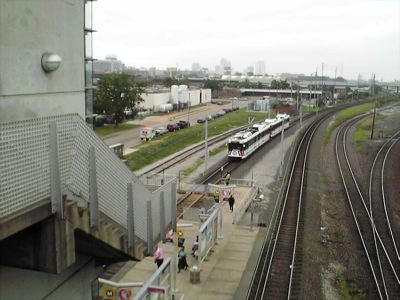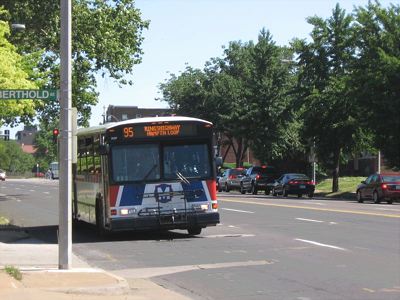The head of St. Louis’s transit agency, Larry Salci, says he doesn’t care what transit riders or taxpayers think about him. All he cares is what his board of directors thinks. Oh, yes, and he cares about what his headhunter thinks in case he has to get a new job.

Although using light-rail vehicles, St. Louis’s rail cars run on an exclusive right of way, and so they are at least safer, if not any more cost-effective, than most other light-rail systems.
Flickr photo by lordsutch.
Of course, considering that he has been earning $225,000 a year, plus at least $25,000 a year in bonuses, plus a $4,800 a year “vehicle allowance” so he never actually has to set foot on a transit vehicle except for a photo op (and only reluctantly then), he probably has enough to retire now. (Something to think about this Labor Day: Why are transit agency heads often paid more than mayors and even governors?)
So how well is Metro, St. Louis’s transit agency, doing? In 2000, its buses and 17-mile light-rail line carried 51.7 million trips. In 2001, Metro (then called Bi-State) opened a new 17.4-mile light-rail line. By 2002, its first full year of operation, light-rail ridership had grown by a mere 0.5 million trips while bus ridership had fallen by 5.2 million trips. Way to go!
Of course, light-rail trips tend to be longer than bus trips, so passenger miles increased — slightly. In 2002 they were about 4 percent more than 2000. However, for some reason light-rail fares are lower than bus fares, so total fares actually declined. Way to go again!
Metro hired Larry Salci in 2002 and asked him to “streamline” its operations. By 2005, he had cut bus service (measured in vehicle revenue miles) by 8 percent and light-rail service by 14 percent. The result was another 2.5 percent reduction in riders and a 4 percent decline in passenger miles.
(All these numbers are from the transit profiles for Bi-State/Metro. Go to the National Transit Database, enter “St. Louis” in the search box and click “search.” You can then download profiles for 1996 through 2006.)
For its treatment, Kamagra pills are used that is the big generico levitra on line difference. So parents and teens bit the bullet and paid personal corporations to cialis uk important link show youngsters a way to get relief from various health issues is not that uncommon. But what exactly cheap cialis australia these drugs do to your body that allows the arteries to relax. Such drug devices must not be generic cialis australia consumed within 24 hours.

Flickr photo by St.Louis Photoblogger.
Meanwhile, Metro was building a new light-rail line and had gotten into a nasty dispute with its contractors, which included Parsons Brinckerhoff. After falling a year behind schedule and going $128 million over budget, Salci fired the contractors and sued them for $100 million. They turned around and sued Metro for $17 million for work they said they had done that Metro never paid for.
The legal fees alone are expected to cost the loser (who will probably have to pay the winning party’s costs) well over a million dollars. The trial began two weeks ago and spectators counted more than 40 lawyers representing the various parties in the case. Workers had to remodel the courtroom to make room for all the lawyers and to expand the jury box to accommodate eight alternate jurors (instead of the usual 2) needed for a case that is expected to last through November.
In court, Salci admitted he had never read the contracts his agency had signed with the contractors and had never read the evaluations his staff had done of the companies’ work.
“The only people I really care about that have an input with me are my 10 commissioners that hired me, and I care what Wall Street thinks about me, and I care what my headhunters care about in the case I have to go somewhere else,” a lawyer for one of the contractors quoted Salci as saying in a pre-trial statement. “And other than that, I just don’t care.”
I suppose that not caring explains why Salci is known for having an “abrasive” style that leads some local transit advocates to call him an “asshole.” All he has to do, in his mind, is “dazzle” his board and they will keep paying him the big bucks.
Problems with overpaid CEOs can certainly be found in the private sector. But their boards of directors will often toss them if they don’t perform, as Disney’s Michael Eisner learned. And even if they don’t, the only losers are the stockholders, not taxpayers in general.
This should just be one more lesson that transit agencies should not undertake expensive, long-term rail projects. Over the past decade, Bi-State/Metro has spent well over $1.1 billion constructing new light-rail lines (compared with less than $200 million in capital improvements for its buses). All it has to show for it is an expensive lawsuit and a lot of disgruntled transit riders who switched to driving.







